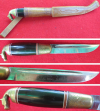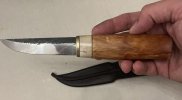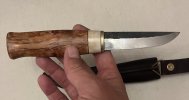I understand your arguments.I find this a bit hard to believe.....
First, its not that easy to bend these as its not just tang you have to bend. The compressed stacked bark is quite solid and provides a lot of resistance to bending. You would need to compress the bark on inside radius of the handle, which is not possible without further damaging the knife. None of the examples shown show any signs of compression. You could no more bend this handle than you could if it had a wood handle. If birchbark handles were really that fragile you'd think its use would have been short lived, not continued for centuries.
As to the bark swelling when wet, yes it will, but like anything made of wood when it dries it will return to its normal size.
Also, if you were to apply enough pressure to actually bend the handle, you would damage the bolster before you bent the tang. The bolsters on these old knives are mostly just thin brass sheeting formed into a cup and secured in place with molten sulphur, referred to by makers as brimstone. This is the weakest point where the tang would start to bend first.
Many older bark handles are coated with a varnish by the maker. If you were to bend the handle that varnish would crack when the layers separate. If you look at the pictures, the knives that are in good condition show the varnish is intact. I also find it hard to believe that so many similar knives are not just bent but all bent exactly the same.....
Oh, by the way, look on page 206 of Ruusuvuoris book on puukkot.....you'll see just such a knife with a non-symmetrical (bent) birchbark handle that was made by Lahdensuo, dated 1940......so yes, they were being made....
That sheath is most likely original, its not the only one like it I have seen. Some decorations and the date may have been added later but there is no reason to believe that its not original to the knife.
I will express my opinion.
The shanks on old Finnish knives are really thin and not hardened. This is done for ease of assembly and riveting at the end of the handle.
All examples of deformed handles are associated with birch bark. Birch bark is a soft material. Much softer than wood or plastic.
The Finns produce dozens of handle shapes for different types of work. If such a shape were in demand, you and I would see it in both wood and plastic. But I could not find such a deformation in other materials.
And covering old handles with new varnish before selling is a long-known trick of the Finns.
I think that this deformation is caused by the tastes of the owners or naturally when doing some work. For example, making blanks for wooden spoons, ladles. When they cut with the cutting edge towards themselves. and the blank is rested against their stomach.



























